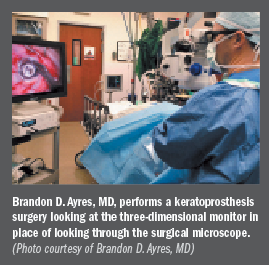Article
State-of-the-art 3-D video designed for ophthalmic surgery
An upgraded three-dimensional viewing and recording system for ophthalmic surgery is a useful tool for the surgeon and surgical team members in the operating room.
Take-home:
An upgraded three-dimensional viewing and recording system for ophthalmic surgery is a useful tool for the surgeon and surgical team members in the operating room.
By Nancy Groves; Reviewed by Brandon D. Ayres, MD
Philadelphia-Advancements to a three-dimensional (3-D) viewing and recording system for ophthalmic surgery (Sony Electronics Medical Systems Division) enhance its value in the operating room and as a teaching tool.
The technology also signifies another step toward the time in the not-too-distant future when surgery is performed while looking at a monitor rather than through a surgical microscope, according to Brandon D. Ayres, MD, with the Cornea Service, Wills Eye Hospital, Philadelphia.
Dr. Ayres has used the video system at the hospital, although he does not own one of the devices himself, and has been impressed with the quality of the images and the speed of transmission. He has also used a TrueVision visualization system, although not the latest version.

Sony’s 3-D visualization system for ophthalmic surgery includes a 3-D camera system, a 3-D medical grade 32-inch monitor, a medical grade 3-D recorder, and a touch screen panel for entering patient data and recorder functions.
A mobile 3-D visualization cart is also available for storing items needed to capture, record, and display 3-D video. The system features backlight technology specifically designed for use in medical environments.
Real-time viewing of procedure
There is virtually no time delay between the surgeon’s actions and what is displayed on screen, which allows everyone in the operating room to watch a surgical procedure in real time, Dr. Ayres said.
This feature could be particularly helpful for staff members, such as scrub nurses or technicians, since in many cases they are unable to visualize the surgery unless looking through the microscope.
The ability to watch the surgery in the same stereo quality as the primary surgeon allows better prediction as to what is needed for the current or next step in the procedure. Better understanding and ability to assist the surgeon leads to improved OR efficiency and possibly patient safety, Dr. Ayres explained.
The Sony 3-D system also has instantaneous transmission of the image, which is critical if performing ophthalmic microsurgery while at a 3-D viewing system.
“Performing surgery while viewing a 3-D display can improve surgeon ergonomics, reduce fatigue, and may allow lower light levels to be used,” Dr. Ayres said. “In fact, as 4K and 8K cameras and monitors become available, it may be better than looking through the scope due to the high quality of the images.”
Value as teaching tool
Both the real-time viewing and recording functions are important at a teaching institution with a steady stream of clinicians arriving to attend educational programs, Dr. Ayres said. With the real-time viewing function, they can almost feel as if they’re doing the surgery themselves, and recordings from prior procedures are invaluable teaching tools.
In many cases several surgeons, residents, and visiting physicians will be in the operating room, but there are only one or two places to view the surgery at the microscope. With the 3-D viewing system, every person in the room has the same advantage as the person sitting at the microscope when watching a new surgical procedure or technique.
Recorded surgical procedures can then be rebroadcast during continuing medical education events in lecture halls, giving each attendee that same advantage as watching the surgery at the microscope. Teaching cases can be recorded and reviewed at a later date to help residents understand why they may have struggled during a case.
Although this would be a less common use for the system, family members of a patient undergoing eye surgery might want to watch the procedure on the monitor, or patients could view video of a recommended procedure to help understand how it is performed.
The functions and quality of the latest version of Sony’s 3-D video system are technically superior and “cool” to use, but from another perspective, their greater value is as a stepping stone to a time when ophthalmic surgery is not performed while looking through a microscope but by using a monitor, Dr. Ayres said.
Vision of the future
This could be standard procedure within a decade, and while not all surgeons are comfortable with that now, using the increasingly sophisticated video systems on the market may help ease them into a new way of doing things, he added.
Many surgical companies are already incorporating video overlay into surgical microscopes. Using a video overlay in 3-D will allow the surgeon to operate in a virtual environment in which gesture control of machinery can be used without breaking the sterile environment.
Brandon D. Ayres, MD
Dr. Ayres did not indicate any proprietary interest in the subject matter.
Subscribe to Ophthalmology Times to receive the latest clinical news and updates for ophthalmologists.
Newsletter
Don’t miss out—get Ophthalmology Times updates on the latest clinical advancements and expert interviews, straight to your inbox.




